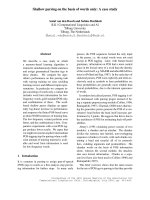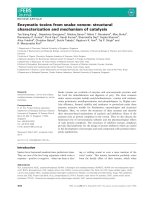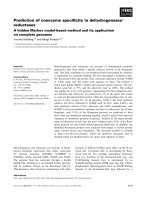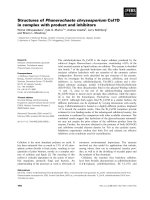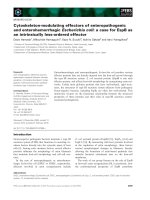Báo cáo khoa học: "Spontaneous pneumothorax from cryptococcal pneumonia in systemic sclerosis: a case report" ppt
Bạn đang xem bản rút gọn của tài liệu. Xem và tải ngay bản đầy đủ của tài liệu tại đây (957.6 KB, 6 trang )
CAS E REP O R T Open Access
Spontaneous pneumothorax from cryptococcal
pneumonia in systemic sclerosis: a case report
Kwanreuthai Sripavatakul and Chingching Foocharoen
*
Abstract
Introduction: Spontaneous pneumothorax is usually found in people with systemic sclerosis who have extensive
pulmonary fibrosis with enlarged sub-pleural blebs. We report a case of spontaneous pneumothorax caused by
cryptococcal pneumonia in a patient with systemic sclerosis with minimal sub-pleural emphysema.
Case presentation: A 49-year-old Thai man with underlying limited cutaneous systemic sclerosis presented with
acute low-grade fever, progressive dyspnea and right pleuritic chest pain for five days. Our patient had pulmonary
fibrosis with bronchiectasis of both lower lungs related to this underlying disease. He received only low-dose
steroid therapy, without any immunosuppressant. A chest radiograph revealed right lung pneumothorax with
cloudy yellow color pleural fluid. Cryptococcal pneumonia was diagnosed by positive identification of the
cryptococcal antigen in the serum and pleural fluid. His symptoms improved after intercostal drainage and
fluconazole therapy.
Conclusion: Infection can exacerbate symptoms in patients with systemic sclerosis with sub-pleural emphysema,
thereby triggering a spontaneous pneumothorax. Pleural fluid–present but not initially seen because of the
pneumothorax–could be a clue to a pre-existing pulmonary infection.
Introduction
Systemicsclerosis(SSC)isararesystemicdiseasewith
the classic clinical characteristic of skin tightness. The
disease is c lassified into two major types: limited cuta-
neous SSC (lcSSC) and diffuse cutaneous SSC (dcSSC).
In lcSSC, the skin on the face, neck and below the
elbows and knees thic ken s, while in dcSSC the thicken-
ing extends to the trunk, arms and thighs.
Internal organ involvement, particularly pulmonary, is
also found i n the disease. Pulmonary complications
include pulmonary fibro sis, pulmonary arterial hypert en-
sion and lung cancer. Most pulmonary fibrosis is found in
cases of dcSSC [1]; however, it also occurs in lcSSC [1].
Spontaneous pneumothorax, related to the underlying
pulmonary fibrosis–particularly lung cyst or bleb, has
been reported as a rare complication of SSC [2,3]. There
are, however, no reports of spontaneous pneumothorax
in SSC, as related to pulmonary infection. We present a
case of underlying lcSSC in a patient who d eveloped
spontaneous pne umothorax related to cr yptococcal
pneumonia.
Case report
A 49-year-old Thai male was diagnosed with lcSSC
according to the 1980 criteria of the American Rheuma-
tism Association [4]. His first presenting symptoms
included sclerodactyly, symmetrical polyarthralgia, digi-
tal pitting scar and Raynaud’ s phenom enon without any
chest symptoms.
Four years after diagnosis, our patient developed dys-
pnea on exertion. The dyspnea worsened in the follow-
ing two years so further investigations were performed.
His chest radiograph revealed interstitial infiltration in
both lower lung zones and prominent pulmonary trunk
(Figure 1). Pulmonary function showed a restrictive pat-
tern; with a forced vital capacity (FVC) of 53%, and
forced expiratory volume in one second/forced vital
capacity (FEV1/FVC) of 105%. High resolution computer
tomography (HRCT) of the chest presented minimal
thickening of the interlobular septa with thickening of
the pleura and mild bronchiectasis in both lower lungs
(Figu re 2). An echocardiogram detected mild concentric
* Correspondence:
Department of Medicine, Faculty of Medicine, Khon Kaen University, Khon
Kaen, 40002, Thailand
Sripavatakul and Foocharoen Journal of Medical Case Reports 2011, 5:309
/>JOURNAL OF MEDICAL
CASE REPORTS
© 2011 Sripavatakul and Foocharoen; licensee BioMed Central Ltd. This i s an Open Access article distributed under the terms of the
Creative Commons Attribution License ( .0), which permits unrestricted use, distribution, and
reprodu ction in any medium, provided the original wor k is properly cited.
left ventricular hypertrophy without pulmonary arterial
hypertension.
Since our patient’s symptoms had worsened, the
attending physician prescribed oral daily cyclophospha-
mide (100 mg per day) plus prednisolone (10 mg per
day). Within three months, the clinical symptoms
improved; however, the follow-up FVC was minimally
decreased with an FVC of 45% and an FEV1/FVC of
90%. Cyclophosphamide was stopped after one year o f
treatment and the steroid tapered off during follow-up.
One year after stopping the cyclophosphamide–but
while still on the prednisolone–the symptoms of dys-
pnea upon exertion returned. A radiograph and HRCT
of the chest were therefore repeated to ascertain the
cause of dyspnea. We observed increased thickening of
the interlobular septa with sub-pleural emphysema and
tubular bronchiectasis of his right lower lung (Figures 3
and 4). Supportive treatment with low-flow oxygen ther-
apy and breathing exercises were prescribed because of
the chronic pulmonary fibrosis.
Our patient was admitted because of a low-grade fever
with pleuritic chest p ain, progressive shortness o f
breath, and a productive cough of five days duration.
On physical examination, he had tachypnea (28 breaths/
Figure 1 Chest radiograph sh owing interstitial infiltration in
both lower lung fields.
Figure 2 HRCT chest scan revealed minimal thickening of the interlobular septa with thickeni ng of the pleura in both lungs and mild
bronchiectasis in both lower lungs.
Sripavatakul and Foocharoen Journal of Medical Case Reports 2011, 5:309
/>Page 2 of 6
minute) and a body temperature of 38.2°C. A lung
examination revealed decreased breath sounds and vocal
resonance of his right lung with a midline trachea posi-
tion. The oxygen saturation of the room air at admis-
sion was 92%.
A complete blood count indicated a hemoglobin level
of 14.2 g/dL, white blood cell count of 8,800 cells/mm
3
,
and a platelet count of 247,000 cells/mm
3
.Achest
radiograph revealed pneumothorax of his right lung
(Figure 5).
Cloudy yellow-colored fluid was found after a chest
tube was inserted. The exudative profile of the pleural
fluid included red blood cell count 890 cells/mm
3
and
white blood cell count 1,890 cells/mm
3
(polymorpho-
nuclear cells 64%, eosinophils 30% and lymphocytes 6%).
Indian ink, Gram stain and acid-fast stain of the pleural
fluid and sputum were negative; however, the pleural
fluid was positive for cryptococcal a ntigen. The respec-
tive culture of the pleural fluid and serum was positive
for Cryptococcus neoformans, while the cerebrospinal
fluid was negative.
Due to desaturation and large air leakage, oxygen sup-
plementation and drainage of his chest were performed
Figure 3 Chest radiograph showing extensive interstitial
infiltration compared to previous chest radiograph.
Figure 4 HRCT chest scan reveals thickening of interl obular septa with sub-pleural emphy sema and tubul ar bronchiectasis of right
lower lung.
Sripavatakul and Foocharoen Journal of Medical Case Reports 2011, 5:309
/>Page 3 of 6
immediately. Oral fluconazole (400 mg per day) was
prescribed after the presence of Cryptococcus was con-
firmed (three days after pneumothorax) and continued
for six months. The fever, pleuritic chest pain and
cough symptoms improved and the lung was re-
expanded the third day after chest tube insertion with-
out any complications. The oxygen line was removed
seven days after treatment. A chest radiograph indicated
improvement of pulmonary infiltration two weeks after
treatment (Figure 6). Four weeks after treatment the
serum cryptococcal antigen test and hemoculture for
Cryptococci were negative. No recurrent pneumothorax
was detected after anti-fungal therapy was discontinued.
Discussion
Spontaneous pneumothorax can be a complication of
infection from invasive necrotizing organisms such as
anaerobic bacteria [5], Staphylococcus [6], Klebsiella
pneumoniae [7], tuberculosis [8,9], asp ergillosis [10,11],
Pneumocystis jiroveci [12], Scedosporium apiospermum
mycetoma [13] or be associated with pre-existing lung
disease such as chronic obstructive pulmonary disease
[5], status asthmaticus [5], cystic fibrosis [5], cancer
[14], thoracic endometriosis [15] or connective tissue
disease [5]. All of the above would be termed secondary
spontaneous pneumothorax (SSP).
SSP in rheumatic diseases have been reported in SSC
[2,3], polymyositis [16], mixed connective tissue disease
[17], systemic lupus erythematosus [18,19], Wegener’s
granulomatosis [20,21], relapsing polychondritis [22],
ankylosing spondylitis [23], and rheumatoid arthritis
[24], particularly in persons with a pre-existing lung dis-
ease associated with an underlying connective tissue dis-
ease. Spontaneous pneumothorax in SSC has been
reported in patients with sub-pleural blebs or lung cysts,
which are perhaps due to abnormal collagen in the pul-
monary tissue as a result of SSC [2,3,25]. An enlarged
sub-pleural cyst, particularly > 1 cm, might be a risk for
spontaneous pneumothorax in patients with SSC [2].
Our patient had pre-existing pulmonary fibrosis
related to his underlying SSC. A HRCT chest scan
revealed only sub-pleural emphysema and he developed
spontaneous pneumothorax after pulmonar y infection.
We conclude that, even though sub-pleural blebs occur
in SSC in associ ation with spontaneous pn eumothorax,
infection can exacerbate symptoms in patients with sub-
pleural emphysema, thereby triggering spontaneous
pneumothorax.
Spontaneous pneumothorax related to cryptococcal
pneumonia has been reported, but mostly in underly-
ing acquired immunodeficiency syndrome (AIDS) [26].
There is one report in a healthy young woman [27].
There are no reports of spo ntaneous pneumothorax
related to cryptococcal pneumonia in persons with
SSC. The pathophysiology of spontaneous pneu-
mothorax could be a result of lung tissue necrosis due
to infection [5], and the pulmonary complications of
SSC could be a predisposing factor for pneumothorax
incaseswherethereisathinning su b-pleural bleb or
bullae.
The objectives of treatment in both primary sponta-
neous pneumothorax (PSP) and SSP are to remove air
from the pleural space and to prevent recurrent
Figure 5 Chest radiography reveals pneumothorax of right
lung.
Figure 6 Chest radiography four weeks after treatment reveals
improvement of pneumothorax and pulmonary infiltration.
Sripavatakul and Foocharoen Journal of Medical Case Reports 2011, 5:309
/>Page 4 of 6
pneumothorax. Importantly, recurrence is higher and the
treatment more difficult in SSP than in PSP [28]; there-
fore, the management in SSP needs to be mo re aggres-
sive. However, it is more difficult to make observations
without any hospital-based treatment, as often occurs
among patients with PSP as opposed to those with SSP,
and there is higher morbidity and mortality among the
latter [29]. Moreover, because the chest symptoms in SSP
are out of proportion with the degree of pneumothorax
[30], the intervention must be prompt in those who can-
not tolerate pneumothorax even if there is only a low
volume of leakage into the pleural space. As for the
patient with symptomatic SSP, the treatment should
include oxygen supplementation to correct any arterial
hypoxemia and air drainage [29]. The treatment options
of air drainage in S SP depend on the patient’s condition
and the size of the air leak into the pleural space.
Our treatment of pneumothorax in daily practice fol-
lows The British Thoracic Society (BTS) Pneumothorax
Guideline [29]. Accordingly, aspirati on can be per-
formed with a 16-18G canula for patients with SSP if
the size of the air leakage into pleural space is between
1-2 cm, whereas a chest tube drainage should be
inserted if the size is > 2 cm [29]. Our patient presented
with severe chest symptoms with hypoxemia and air
leakage into pleural space > 2 cm [29], thus there was
no doubt about the treatment option. Chest tube drai-
nage and oxygen therapy were immediately performed
on our patient. As per the BTS guideline, neither pleur-
odesis nor surgical strategy was performed on our
patient because the lung was re-expanded, the air leak
was resolved and there was no recurrence of the pneu-
mothorax (after chest tube drainage).
In most cases, lun g re-expansion will lead to ra pid
recovery; however, re-expansion may be delayed in a
patient with SSP [31] or even in SSC [3]. Pneumothorax
has b een known to recur in cases of SSC [2,25], and so
pleurodesis will be the final treatment in most cases of
SSC. Slow lung re-expansion and recurrent pneu-
mothorax in SSC may be explained by poor lung com-
pliance, multiple sub-pleural cysts and pleural-
thickening and fibrosis [2,3].
In contrast to previous reports, our patient had full
lung re-expansion within three days of chest tube inser-
tion and a nti-fungal therapy. The rapid re covery of the
lung after re-expansion might be related to early anti-
fungal treatment and early che st tube drainage. The
prognosis of lung re-expansion in SSP due to infection
might be better than pneumothorax due to ruptured
sub-pleural bleb in a patient with underlying SSC.
In general, pleural effusion will not be detected in the
ipsilateral lung of pneumothorax because the pressure
in the pleural space w ill obscure the hydrostatic pres-
sure of the interstitial fluid and there is, therefore, no
movement of interstitial fluid into the pleural space [5].
Our patient had pleural fluid after chest tube insertion
and the specific cause of pneumothorax came from
pleural fluid analysis. Therefore pleural fluid can be a
sign of a pre-existing pulmonary infection in cases of
spontaneous pneumothorax.
Conclusions
Infection can exacerbate symptoms in a patient with sys-
temic sclerosis with sub-pleural emphysema, thereby trig-
gering spontaneous pneumothorax, even when minimal
sub-pleural emphysema is detected. Pleural fluid–present
but not initially seen because of the pneumothorax–
could be a clue to a pre-existing pulmonary infection.
Consent
Written informed consent was obtained from our patient
for the publication of this case report and any accompa-
nying images. A copy of the wr itten consent is available
for review by the Editor-in-Chief of this journal.
Acknowledgements
The authors thank the Department of Medicine and the Faculty of Medicine
for their support on the approval of this manuscript, and Mr Bryan Roderick
Hamman and Mrs Janice Loewen-Hamman for assistance with the English-
language presentation of the manuscript. Our patient was admitted under
the care of a rheumatologist and was followed up in an out-patient
scleroderma clinic.
Authors’ contributions
All authors reviewed and approved the final manuscript.
Competing interests
The authors declare that they have no competing interests.
Received: 14 August 2010 Accepted: 13 July 2011
Published: 13 July 2011
References
1. Ostojić P, Damjanov N: Different clinical features in patients with limited
and diffuse cutaneous systemic sclerosis. Clin Rheumatol 2006,
25(4):453-457.
2. Lang B, Ortlieb H, Meske S, Hauke G, Peter HH: Progressive systemic
sclerosis presenting with spontaneous pneumothorax. J Rheumatol 1989,
16(2):254-256.
3. Ng SC, Tan WC: Bilateral spontaneous pneumothorax in systemic
sclerosis–report of two cases. J Rheumatol 1990, 17(5):689-691.
4. Subcommittee for scleroderma criteria of the American Rheumatism
Association Diagnostic and Therapeutic Criteria Committee: Preliminary
criteria for the classification of systemic sclerosis (scleroderma). Arthritis
Rheum 1980, 23(5):581-590.
5. Sahn SA, Heffner JE: Spontaneous pneumothorax. N Engl J Med 2000,
342(12):868-874.
6. Kowalski R, Wasikowa R, Cholewicka A: Bilateral pneumothorax in the
course of staphylococcal septicemia in a 12-year-old boy. Wiad Lek 1971,
24(14):1373-1376.
7. Fathy A, Omar HR: Klebsiella-induced pneumothorax. Intern Med 2010,
49(23):2639.
8. Belmonte R, Crowe HM: Pneumothorax in patients with pulmonary
tuberculosis. Clin Infect Dis 1995, 20(6):1565.
9. Freixinet JL, Caminero JA, Marchena J, Rodríguez PM, Casimiro JA,
Hussein M: Spontaneous pneumothorax and tuberculosis. Long-term
follow-up. Eur Respir J 2010.
Sripavatakul and Foocharoen Journal of Medical Case Reports 2011, 5:309
/>Page 5 of 6
10. Hiura K, Katoh O, Kawashima M, Nakata H, Aoki Y, Nakahara Y, Kuroki S,
Yamada H: A case of spontaneous pneumothorax due to rupture of bleb
infected with aspergillosis. Nihon Kyobu Shikkan Gakkai Zasshi 1993,
31(3):364-367.
11. Winne L, Praet M, Brusselle G, Veys E, Mielants H: Bilateral spontaneous
pneumothorax in a patient with pulmonary rheumatoid nodules,
secondary infected by Aspergillus. Clin Rheumatol 2007, 26(7):1180-1182.
12. Beers MF, Sohn M, Swartz M: Recurrent pneumothorax in AIDS patients
with Pneumocystis pneumonia. A clinicopathologic report of three cases
and review of the literature. Chest 1990, 98(2):266-270.
13. Hassan T, Nicholson S, Fahy R: Pneumothorax and empyema complicating
Scedosporium apiospermum mycetoma: not just a problem in the
immunocompromised patients. Ir J Med Sci 2010.
14. Cummings NM, Desai S, Thway K, Stewart S, Hill DA, Priest JR,
Nicholson AG, Rintoul RC: Cystic primary pulmonary synovial sarcoma
presenting as recurrent pneumothorax: report of 4 cases. Am J Surg
Pathol 2010, 34(8):1176-1179.
15. Korom S, Canyurt H, Missbach A, Schneiter D, Kurrer MO, Haller U, Keller PJ,
Furrer M, Weder W: Catamenial pneumothorax revisited: clinical
approach and systematic review of the literature. J Thorac Cardiovasc
Surg 2004, 128(4):502-508.
16. Gayraud M, Lhote F, Valeyre D, Kemeny JL, Khellaf M, Battesti JP:
Pneumothorax and pneumomediastinum associated with
dermatomyositis. Ann Med Interne (Paris) 1989, 140(6):490-491.
17. Hoshino T, Kita M, Takahashi T, Nishimura T, Yamakawa M: Management of
two pregnancies in a woman with mixed connective tissue disease,
pulmonary fibrosis, frequent pneumothorax and oxygen inhalation
therapy along with a published work review. J Obstet Gynaecol Res 2008,
34(4 Pt 2):613-618.
18. Maeda R, Isowa N, Miura H, Tokuyasu H: Systemic lupus erythematosus
with multiple lung cysts. Interact Cardiovasc Thorac Surg 2009,
8(6):701-702.
19. Tanaka N, Kusunoki Y, Kaneko K, Yamamoto T, Kaburaki M, Muraoka S,
Abe H, Endo H, Sato D, Homma S, Shibuta K, Kawai S: Systemic lupus
erythematosus complicated by recurrent pneumothorax: Case report
and literature review. Nihon Rinsho Meneki Gakkai Kaishi 2010,
33(3):162-168.
20. Delèvaux I, Khellaf M, André M, Michel J, Piette JC, Aumaître O:
Spontaneous pneumothorax in Wegener granulomatosis. Chest 2005,
128(4):3074-3075.
21. Storelli E, Casali C, Natali P, Rossi G, Morandi U: Unusual pathogenesis of
spontaneous pneumothorax secondary to Wegener’s granulomatosis.
Ann Thorac Surg 2007, 84(1):288-290.
22. Lin Y, Zuo Z, Lo P, Hseu S, Chang W, Chan KH, Yuan HB: Bilateral tension
pneumothorax and tension pneumoperitoneum secondary to tracheal
tear in a patient with relapsing polychondritis. J Chin Med Assoc 2009,
72(9):488-491.
23. Wang C, Tsen J, Lin H, Cheng H: Bilateral spontaneous pneumothorax in
a patient with ankylosing spondylitis. Eur J Emerg Med
2007,
14(2):123-124.
24. Saravana S, Gillott T, Abourawi F, Peters M, Campbell A, Griffith S:
Spontaneous pneumothorax: an unusual presentation of rheumatoid
arthritis. Rheumatology (Oxford) 2003, 42(11):1415-1416.
25. Yoon J, Finger DR, Pina JS: Spontaneous Pneumothorax in Scleroderma. J
Clin Rheumatol 2004, 10(4):207-209.
26. Alonso-Villaverde C, Hernández-Flix S, Tomás R, Masana L: Occurrence of
pneumothorax and pneumomediastinum in a patient with AIDS and
pulmonary infection caused by Pneumocystis carinii and Cryptococcus
neoformans. Rev Clin Esp 1992, 191(7):397-398.
27. Shibuya Y, Kitamura S, Sohara Y, Saitoh K: A case of primary pulmonary
cryptococcosis associated with pneumothorax [abstract]. Nihon Kyobu
Shikkan Gakkai Zasshi 1995, 33(5):548-552.
28. Guo Y, Xie C, Rodriguez RM, Light RW: Factors related to recurrence of
spontaneous pneumothorax. Respirology 2005, 10(3):378-384.
29. MacDuff A, Arnold A, Harvey J: Management of spontaneous
pneumothorax: British Thoracic Society Pleural Disease Guideline 2010.
Thorax 2010, 65(Suppl 2):ii18-31.
30. Vail WJ, Alway AE, England NJ: Spontaneous pneumothorax. Dis Chest
1960, 38:512-515.
31. Mathur R, Cullen J, Kinnear WJ, Johnston ID: Time course of resolution of
persistent air leak in spontaneous pneumothorax. Respir Med 1995,
89(2):129-132.
doi:10.1186/1752-1947-5-309
Cite this article as: Sripavatakul and Foocharoen: Spontaneous
pneumothorax from cryptococcal pneumonia in systemic sclerosis: a
case report. Journal of Medical Case Reports 2011 5:309.
Submit your next manuscript to BioMed Central
and take full advantage of:
• Convenient online submission
• Thorough peer review
• No space constraints or color figure charges
• Immediate publication on acceptance
• Inclusion in PubMed, CAS, Scopus and Google Scholar
• Research which is freely available for redistribution
Submit your manuscript at
www.biomedcentral.com/submit
Sripavatakul and Foocharoen Journal of Medical Case Reports 2011, 5:309
/>Page 6 of 6


